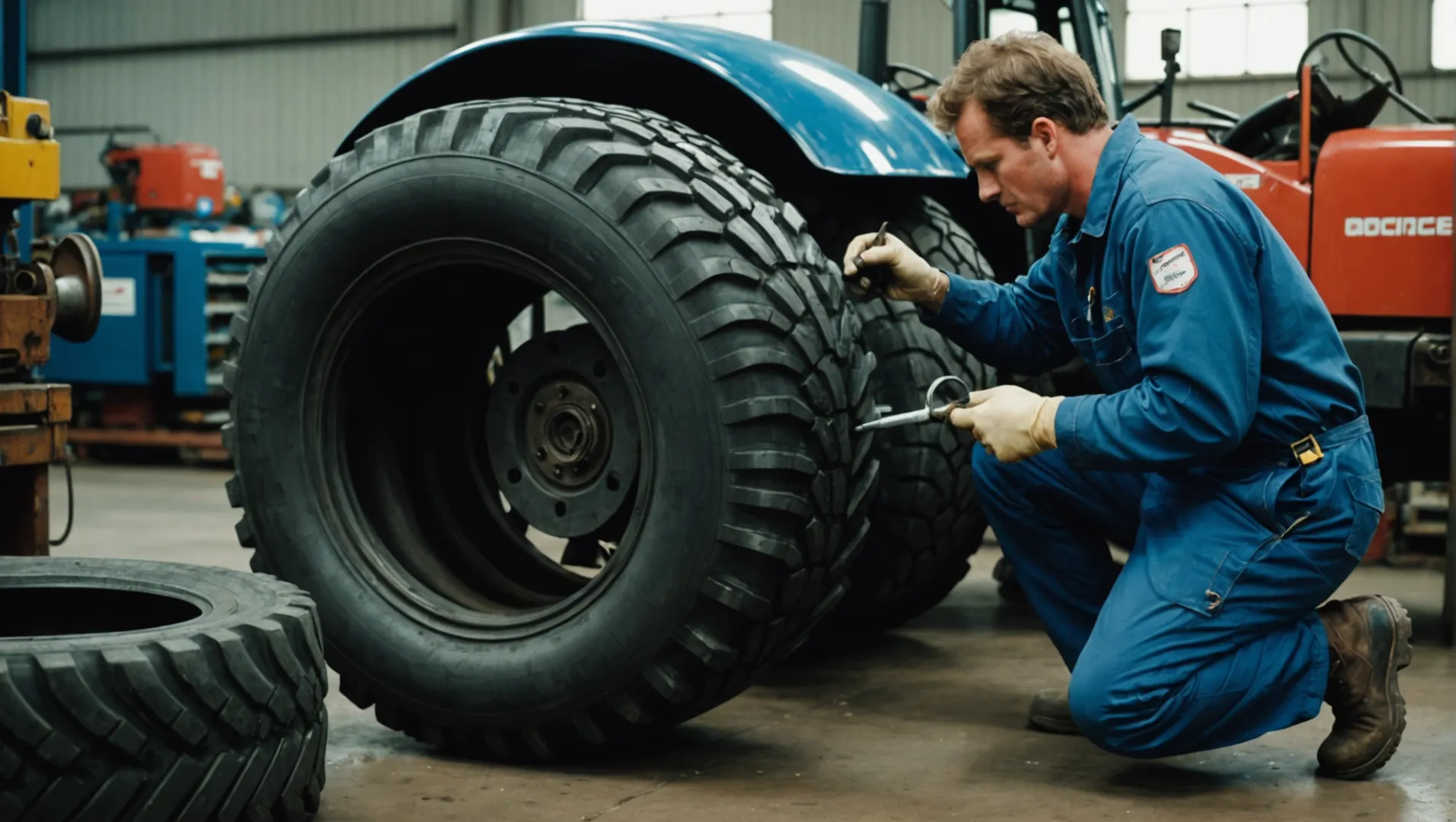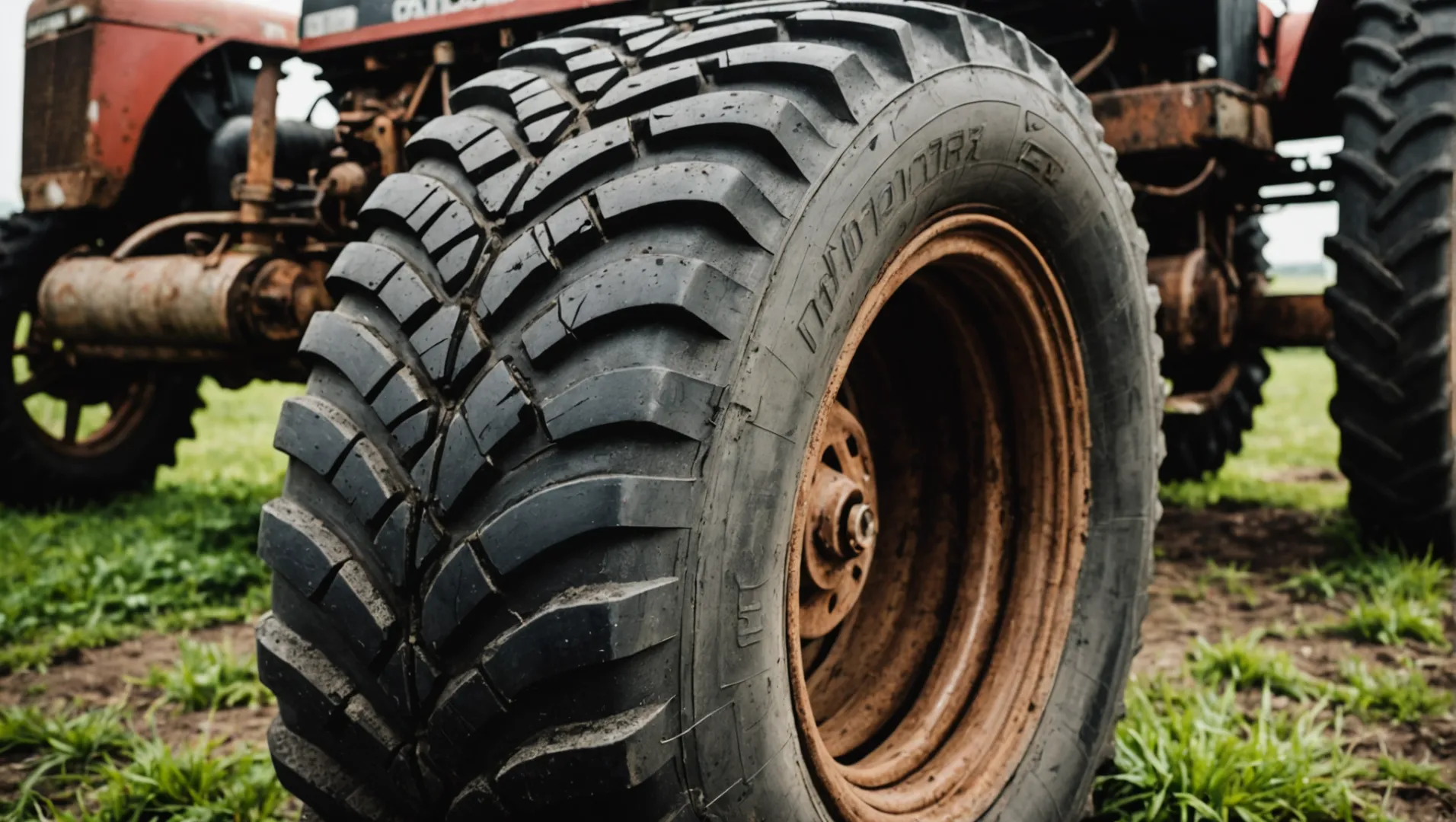Have you ever wondered how long your tractor tires will last? Let’s dive into the world of tractor tires together!
Tractor tires typically last between 3,000 to 5,000 hours of use, depending on factors like terrain, load, and maintenance. Regular inspections and proper storage can extend their lifespan, while harsh conditions may reduce it.
To maximize the life of your tractor tires and ensure safety and cost-effectiveness in your operations, let's explore the factors influencing tire wear and effective maintenance strategies.
Tractor tires typically last 3,000 to 5,000 hours of use.True
This range accounts for average wear based on usage factors like terrain and load.
How Do Usage Factors Affect Tractor Tire Longevity?
Understanding the factors that affect tractor tire longevity can save costs and ensure safety.
Usage factors like terrain, load, hours of use, and tire inflation significantly impact tractor tire longevity. Regular maintenance and proper usage can extend tire life, while harsh conditions can lead to premature wear.

Hours of Use
The lifespan of a tractor tire is directly proportional to the number of hours it is used. Typically, the more hours a tire endures, the quicker it wears down. This wear is unavoidable, but by monitoring usage and balancing workloads, you can potentially extend the tire's useful life. Keeping a log of operating hours1 can help in planning timely replacements and maintenance.
Terrain Challenges
The type of terrain your tractor navigates plays a crucial role in determining tire longevity. Rough and uneven terrains, such as rocky fields or areas with debris, can cause rapid wear and tear. Conversely, smooth and well-maintained surfaces reduce stress on tires. Farmers operating in challenging terrains should consider investing in durable tire types2 specifically designed to handle harsh conditions.
Load Management
Carrying heavy loads consistently places extra stress on tractor tires, leading to accelerated wear. The heat generated from carrying excess weight can also cause the rubber to deteriorate faster. To mitigate this, it's essential to distribute loads evenly and avoid overloading. Utilizing a load distribution calculator3 can assist in managing weight effectively.
Tire Inflation
Proper inflation is critical for maximizing tire longevity. Over-inflated tires may not absorb shocks well, leading to increased wear on the tread's center, while under-inflated tires can cause sidewall damage and uneven tread wear. Regularly checking and maintaining optimal tire pressure4 ensures even wear and reduces the risk of blowouts.
By understanding these usage factors, you can make informed decisions that enhance the lifespan of your tractor tires and ensure your operations remain efficient.
Terrain type affects tractor tire longevity.True
Rough terrains cause rapid wear, reducing tire lifespan.
Over-inflated tires last longer than under-inflated ones.False
Over-inflation leads to center tread wear, reducing lifespan.
What Maintenance Practices Extend Tire Life?
Maximizing tire life not only saves money but also enhances safety and performance.
Regular tire inspections, maintaining correct pressure, and avoiding chemical exposure are key practices that extend tire life.

Importance of Regular Inspections
Performing regular inspections is paramount in extending tire life. These inspections should include checking for cuts, bulges, and signs of wear or damage. Identifying issues early can prevent further damage and potential tire failures. Additionally, cleaning tires to remove any oils or farm chemicals can prevent premature degradation, ensuring longevity.
Proper Tire Inflation
Maintaining proper tire pressure is crucial for even wear and optimal performance. Over-inflated tires can lead to a harsher ride and increased wear on the center of the tread, while under-inflated tires may cause excessive wear on the edges and increase the risk of blowouts. Utilizing a reliable pressure gauge to regularly monitor tire pressure is recommended.
- Optimal Pressure Levels:
| Tire Type | Recommended Pressure (psi) |
|---|---|
| Front Tires | 15-25 |
| Rear Tires | 18-30 |
Regularly checking and adjusting pressure according to the manufacturer's guidelines can significantly enhance tire life.
Protecting Tires from Chemical Exposure
Tires exposed to oils, farm chemicals, and other corrosive substances can degrade faster. It is essential to clean tires regularly and ensure that they are free from harmful residues. If possible, store equipment in a clean area away from chemical exposure to protect the rubber components.
Implementing a Routine Maintenance Schedule
Creating a comprehensive maintenance schedule that includes regular inspections, cleaning, and pressure checks can prolong tire life. Documenting these activities ensures consistency and helps track any recurring issues.
By following these maintenance practices5, you can extend the life of your tractor tires and ensure they perform efficiently over time.
Proper tire inflation prevents uneven tread wear.True
Correct pressure ensures even distribution of weight, reducing wear.
Ignoring chemical exposure has no effect on tire life.False
Chemicals can degrade rubber, leading to premature tire failure.
How Do Environmental Conditions Influence Tire Wear?
Environmental factors play a crucial role in determining the lifespan of your tractor tires.
Environmental conditions like sun exposure, temperature extremes, and improper storage can significantly accelerate tire wear, leading to reduced lifespan and increased maintenance costs.

Sun Exposure: The Hidden Enemy
One of the most underrated factors affecting tire wear is sun exposure. Constant exposure to UV rays can lead to rubber degradation, causing cracks and making the tires brittle over time. This not only compromises safety but also reduces the overall lifespan of your tires. To mitigate these effects, consider storing your vehicles indoors or using tire covers when not in use.
Temperature Extremes: Hot and Cold Challenges
Both high and low temperatures pose challenges to tire longevity. In hot conditions, the rubber can soften, leading to increased friction and accelerated wear. Conversely, cold temperatures can make the rubber less flexible, increasing the risk of cracking under pressure. It's advisable to monitor weather forecasts and adjust your tire usage accordingly during extreme weather conditions.
Storage Solutions: Indoor vs. Outdoor
Improper storage can significantly impact tire wear. Tires stored outdoors are more vulnerable to weather-related damage compared to those stored indoors or covered. Innovative storage solutions6 can help protect your tires from environmental factors, extending their lifespan. Always aim to store tires in a cool, dry place away from direct sunlight and temperature fluctuations.
Table: Environmental Impact on Tire Wear
| Environmental Condition | Effect on Tire Wear | Mitigation Strategy |
|---|---|---|
| Sun Exposure | Cracks and brittleness | Use covers/store indoors |
| High Temperatures | Softening and increased friction | Monitor usage patterns |
| Low Temperatures | Reduced flexibility, cracking | Avoid usage during extreme cold |
| Outdoor Storage | Increased weather-related wear | Store in a protected area |
Understanding these environmental impacts can help you develop strategies to prolong the life of your tractor tires, ultimately saving costs and enhancing farm productivity.
Sun exposure accelerates tire wear by causing cracks.True
UV rays degrade rubber, leading to cracks and brittleness.
Cold temperatures make tires more flexible and durable.False
Cold makes rubber less flexible, increasing cracking risk.
When Should You Replace Tractor Tires?
Recognizing the right time to replace tractor tires is key to maintaining productivity and safety on the farm.
Tractor tires should be replaced when they show signs of excessive wear, damage, or age, such as thinning tread, sidewall cracks, or a lifespan of over 10 years, even if tread appears intact. Regular inspections can help detect these issues early.

Signs of Wear and Damage
Tractor tires often endure tough conditions, leading to wear and tear that might not be immediately visible. Here are some common indicators that it's time for a replacement:
- Tread Wear: The depth of the tire tread is a primary sign of wear. Tires with significantly worn treads will have reduced traction, especially on wet or uneven surfaces. Use a tread depth gauge to measure it regularly.
- Sidewall Cracks: Inspect the sidewalls for cracks or cuts. These can indicate aging rubber or damage from sharp objects, compromising the tire's integrity.
- Bulges and Blisters: These are signs of internal damage and can lead to tire failure. They result from air or moisture penetrating the tire layers, usually due to impacts or punctures.
Considering Tire Age
Even without visible damage, the age of the tire is a critical factor. Rubber degrades over time, losing elasticity and strength. Most manufacturers recommend replacing tractor tires every 5 to 10 years regardless of use. Checking the manufacturing date stamped on the tire can help determine its age.
Performance Issues
A decrease in performance is another clue for replacement. Reduced traction, increased fuel consumption, or difficulty in steering can all indicate that your tires are no longer efficient. If your tractor feels less stable or exhibits unusual vibrations, it's time for an inspection.
Usage and Environmental Impact
- Frequent Heavy Loads: Consistently carrying heavy loads accelerates tire wear due to increased stress. Evaluate the frequency and weight of your loads to assess their impact on your tires.
- Harsh Terrain: Rocky, uneven terrain can quickly wear down tire treads and damage sidewalls. Consider more robust tires if your work environment involves such conditions frequently.
- Weather Exposure: Prolonged exposure to sunlight and extreme temperatures can degrade tires faster. Protecting stored tires from weather elements can help extend their life.
To learn more about maintaining tractor tires7 effectively, consider exploring expert advice and guidelines to ensure your equipment remains in optimal condition.
Tractor tires should be replaced every 5 to 10 years.True
Rubber degrades over time, so manufacturers recommend replacing tires every 5-10 years.
Sidewall cracks are not a concern for tractor tires.False
Sidewall cracks indicate aging rubber or damage, compromising tire integrity.
Conclusion
By prioritizing maintenance and understanding usage factors, you can significantly extend your tractor tires' lifespan, ensuring efficient farm operations.
-
Helps track tire usage for effective maintenance planning.: Use engine hrs, I mark the hrs and date on the oil filter with a paint marker. I Also write it in the tractor op manual so it's handy and a ... ↩
-
Assists in selecting durable tires for challenging environments.: Most agricultural operations will find the best options are R-1 and R-3 tires, but if you've got wet land or are operating on hard ground, look for R-2 and R-4 ... ↩
-
Guides on balancing load to prevent excessive tire wear.: In part 1 of this video series, you will learn how to choose the appropriate weight split ... ↩
-
Provides information on maintaining correct tire pressure for longevity.: I would put 32-35 psi in the front tires and 18-20 psi in the rears. So, just up the fronts a little and you're good. ↩
-
Discover detailed maintenance techniques for prolonging tractor tire life.: A visual inspection is a great first step in maintaining your tractor's tires. Obvious issues like low pressure and tears can be easily spotted ... ↩
-
Explore solutions to protect tires from environmental damage.: Tire carousels and tire storage racks organize to maximize floor space, improve employee safety, and increase productivity. ↩
-
Discover expert tips to keep your tractor tires in top shape.: Use soap, water and a good tire brush. Then wipe the tires down completely and allow them to air dry. Do not speed! Farm tractor tires are spending more and ... ↩




